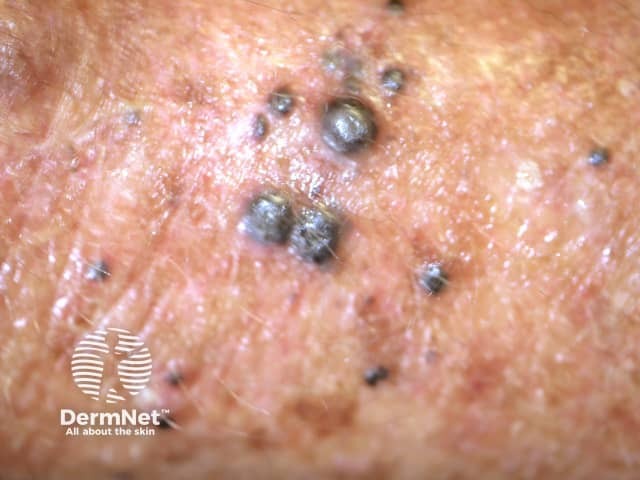Main menu
Common skin conditions

NEWS
Join DermNet PRO
Read more
Quick links
Lesions (cancerous) Systemic diseases
Author: Aamenah Al-Ani, Medical Student, University of Auckland, New Zealand. DermNet Editor in Chief: Adjunct A/Prof Amanda Oakley, Dermatologist, Hamilton, New Zealand. Copy edited by Gus Mitchell/Maria McGivern. March 2018.
Introduction Demographics Causes Clinical features Diagnosis Treatment Outcome
Metastatic melanoma with unknown primary (MUP) refers to metastatic melanoma in lymph nodes, subcutaneous tissue, or visceral sites in the absence of a detectable primary tumour despite detailed examination [1]. Metastatic melanoma should be considered in the differential diagnosis for any patient presenting with a malignancy of unknown origin.
Melanoma commonly metastasises to the regional lymph nodes, liver, lungs, bone, or brain, spreading through lymphatic and haematogenous routes . It can also metastasise to the skin, either locally or to distant sites [2].
For classification purposes, MUP can be separated into subcutaneous, nodal, and visceral disease, with nodal MUP being the most common.

Cutaneous melanoma

Subcutaneous melanoma

Nodal melanoma
See more images of metastatic melanoma.
MUP accounts for approximately 2–9% of cases of metastatic melanoma [3]. The mean age of patients presenting with MUP is in the fifth and sixth decades of life [4]. It more commonly presents in men than in women. This sex difference is currently unexplained.
The origin of MUP is not fully understood. Some possible explanations are included below.
Genotyping of MUP shows a mutational pattern similar to cutaneous melanoma and not the pattern seen in primary melanoma arising in other sites, such as the mucosa or central nervous system. MUP mutations include mutations in the BRAF (particularly the V600E subtype) and NRAS genes [6]. This lends support to the theory that MUP represents metastases from an original primary cutaneous melanoma that may or may not have regressed.
As the primary site of the melanoma is unknown, the presentation of MUP is atypical, in that there is no clinically apparent primary cutaneous lesion.
Rarely, the primary melanoma is later found at an extracutaneous site, such as in the eye, or in a sinonasal, vulvovaginal, or gastrointestinal area. In most cases, the primary melanoma cannot be found [6].
The most common clinical presentation of MUP is lymph node disease without clinical or radiological evidence of visceral involvement. Lymph node metastases commonly arise in the axillary (50%), neck (26%), and groin (20%) lymph nodes [1].
In cases of MUP spreading to visceral sites, the initial symptoms are site-specific.
Advanced MUP that has spread to distant sites may also present with systemic features related to cytokine production, such as fever, weight loss, and anaemia [7].
The diagnosis of MUP is usually made based on clinical signs and symptoms consistent with metastatic disease, along with histopathology of a tissue specimen that confirms the presence of malignant melanocytes, such as excisional biopsy of the lymph node or needle core biopsy of a solid organ metastasis [8].
The histological features of MUP on a tissue specimen include:
It is currently not possible to predict the primary site of MUP from histology, immunohistochemistry, or genetics [8].
The requirement of an extensive physical examination to search for the primary lesion has been questioned. Examinations such as ophthalmoscopy (eye examination by ophthalmoscope), otoscopy (ear examination with otoscope), rhinopharyngoscopy (nasal endoscopy and examination of upper airways), laryngoscopy (examination of the inside of the larynx), sigmoidoscopy (rectal examination) and, in women, gynaecological examination, have traditionally been undertaken, yet the yield in finding a primary lesion is not high. These examinations may be costly, time-consuming, and uncomfortable for patients. Special physical examinations are undertaken using clinical judgement in individual cases [4].
Other recommended investigations for MUP include CT imaging of the head, neck, brain (preferably by MRI), chest, abdomen, and pelvis to detect any visceral involvement. CT-PET scanning may also aid in staging the disease.
Studies have shown that lymph node and subcutaneous MUP have a better prognosis than stage III melanoma of a known primary site. The American Joint Committee on Cancer (AJCC) recommends:
For nodal MUP, radical lymph node dissection of the affected region is generally undertaken. Patients who undergo surgery are less likely to have a recurrence of the malignancy and have improved survival compared to patients undertaking other treatments. Some patients with stage III MUP may benefit from adjuvant systemic and radiation therapy with identical criteria to patients with a known primary melanoma when undergoing the same treatment [1,10].
Subcutaneous MUP behaves more like thick primary melanoma and is generally treated by wide local excision and sentinel lymph node biopsy, if indicated. An epidermal component is sometimes identified in the wide local excision specimen, establishing it as primary cutaneous melanoma rather than MUP [10].
A full metastatic work-up is undertaken for MUP that develops in a visceral site, including cross-sectional imaging. Management involves the resection of any isolated lesion where possible.
While adjuvant therapy has an established role in stage III MUP, its role is unclear in stage IV MUP [10].
Results from studies comparing patients with patients with MUP with matched groups of patients with cutaneous melanoma have shown that MUP has similar or better overall survival rates than cutaneous melanoma.
A 2015 systematic review and meta-analysis by Bae et al showed that compared with melanoma of known primary, MUP has a better overall survival, with a hazard ratio of 0.83 for stage III disease and a hazard ratio of 0.85 for stage IV disease [11].
Favourable prognostic factors include:
Patients with MUP may have improved survival because there may be a more active tumour-directed immune response against the malignant cells (supporting the idea that MUP may be a result of tumour regression) than in melanoma of known primary [13].